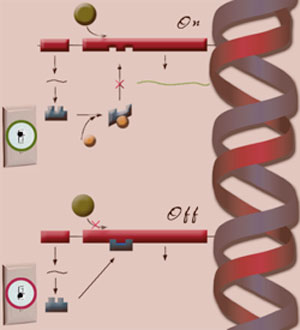Concept 33 Genes can be turned on and off.

As researchers untangled the genetic code and the structure of genes in the 1950s and 60s, they began to see genes as a collection of plans, one plan for each protein. But genes do not produce their proteins all the time, suggesting that organisms can regulate gene expression. French researchers first shed light on gene regulation using bacteria.
When lactose is available, E. coli turn on an entire suite of genes to metabolize the sugar. Researchers tracked the events lactose initiates and found that lactose removes an inhibitor from the DNA. Removing the inhibitor turns on gene production.
The gene that produces the inhibitor is a regulatory gene. Its discovery altered perceptions of development in higher organisms. Cells not only have genetic plans for structural proteins within their DNA, they also have a genetic regulatory program for expressing those plans.
 DNA is packaged in a chromosome.
DNA is packaged in a chromosome. Higher cells incorporate an ancient chromosome.
Higher cells incorporate an ancient chromosome. Some DNA does not encode protein.
Some DNA does not encode protein. Some DNA can jump.
Some DNA can jump. Genes can be turned on and off.
Genes can be turned on and off. Genes can be moved between species.
Genes can be moved between species. DNA responds to signals from outside the cell.
DNA responds to signals from outside the cell. Different genes are active in different kinds of cells.
Different genes are active in different kinds of cells. Master genes control basic body plans.
Master genes control basic body plans. Development balances cell growth and death.
Development balances cell growth and death. A genome is an entire set of genes.
A genome is an entire set of genes. Living things share common genes.
Living things share common genes. DNA is only the beginning for understanding the human genome.
DNA is only the beginning for understanding the human genome.